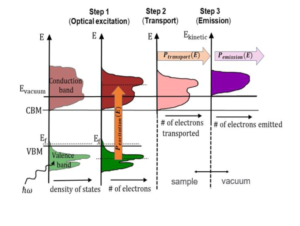
3-Step Photoemission Model
Researchers from Arizona State University, Northern Illinois University, Cornell University, Euclid Beamlabs, and Lawrence Berkeley National Laboratory are collaborating to improve the performance of x-ray FELs, ultrafast electron diffraction, electron beam cooling and energy recovery linacs by developing a new paradigm for the photoemission formalism that captures the subtleties of the cathodes used in linac-based applications.
In Theory of Photoemission from Cathodes with Disordered Surfaces the multidisciplinary team’s model re-evaluates photoemission steps (excitation, transport and emission) and obtains the same quantum efficiency (QE) and mean transverse energy (MTE) relationships without the need to use unphysical assumptions. Therefore, the model can be realistically applied to defective thin-film semiconductor cathodes along with metal cathodes.
Furthermore, the model predicts values of QE and MTE from polycrystalline Cs3Sb cathodes in excellent agreement with those observed experimentally at both room and cryogenic temperatures. The article also considers defect states as the possible limiting factor in maximizing the brightness of electron beams.
See the entire article at J. Appl. Phys. 133, 053102 (2023) (https://doi.org/10.1063/5.0135629) Figure reproduced with the permission of AIP Publishing.

